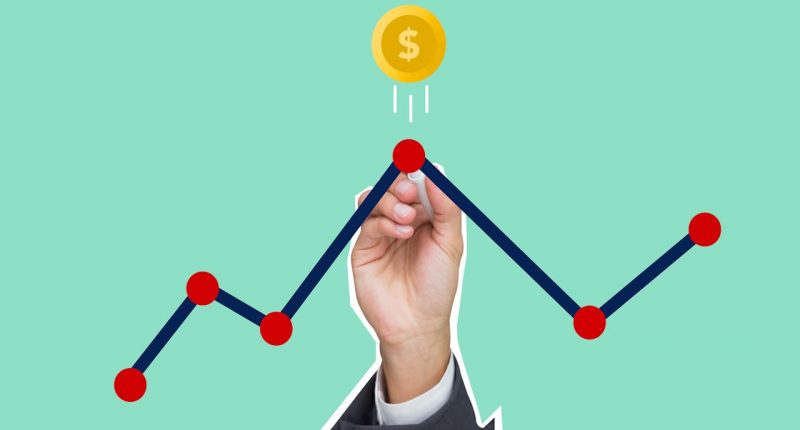Curious to know how global trends affect your investments? You invest, you save. But if you don’t understand global trends, you might end up making the wrong move at the wrong time. Ever noticed how when the US dollar gets stronger, gold prices often drop, and when the dollar weakens, gold seems to shine? This isn’t just a coincidence. It is the US Dollar and Gold Inverse Relationship.
In this blog, we will break down this inverse relationship and why it matters to you.
What Is the US Dollar Index (DXY)?
The US Dollar Index (DXY) is a tool that measures the value of the US dollar against a group of major foreign currencies. It was first introduced in 1973 by the US Federal Reserve. The index is widely used by traders, economists, and policymakers to understand how the dollar is performing on the global stage.
The DXY compares the dollar to a basket of six major world currencies:
- Euro (EUR) – which has the highest weight in the index (about 57.6%)
- Japanese Yen (JPY)
- British Pound (GBP)
- Canadian Dollar (CAD)
- Swedish Krona (SEK)
- Swiss Franc (CHF)
Together, these currencies represent America’s most significant trading partners.
The index starts with a base value of 100. If the DXY rises above 100, it means the dollar is getting stronger compared to the basket of currencies. If it falls below 100, the dollar is getting weaker.
For example, if the DXY moves from 100 to 105, it means the dollar has strengthened by 5%. If it drops from 100 to 95, it has weakened by 5%.

Why Is the DXY Important?
The DXY is not just a number. It reflects the world’s confidence in the US economy. Here’s why it matters:
A strong dollar (high DXY) means more purchasing power for US consumers when buying imported goods.
A weak dollar (low DXY) can make US exports more competitive, as foreign buyers find American goods cheaper.
In financial markets, many investors watch the DXY closely. A rising DXY shows economic strength or global demand for the dollar. But a falling DXY reflects inflation, recession, or global shifts away from the dollar.
Who Uses the Dollar Index?
- Currency traders use it to spot trading opportunities.
- Importers and exporters use it to understand cost changes in global trade.
- Central banks and policymakers use it to make decisions about interest rates and monetary policy.
- Investors in gold and commodities track it because it moves inversely to gold prices.
Why Do Gold and the US Dollar Move in Opposite Directions?
At first glance, gold and the US dollar may seem unrelated. One is a shiny metal, and the other is a modern fiat currency. But they have a unique relationship – they move in opposite directions. Why?
Globally, gold is priced in US dollars. That means when the value of the dollar rises, it takes fewer dollars to buy the same amount of gold. As a result, gold becomes cheaper in dollar terms, and its price tends to fall.
But when the dollar weakens, you need more dollars to purchase the same amount of gold. This makes gold prices go up.
Any other reason for this trend?
1) The Safety Choice
During times of war, pandemics, or economic crises, investors search for safe places to put their money.
Some of the investors select the US dollar because they trust the strength of the US economy. Others turn to gold because it doesn’t depend on governments or central banks.
However, investors usually don’t invest in both gold and the US dollar at the same time. When people trust the dollar, they buy more of it, and gold prices fall. But when confidence in the dollar drops, investors go to gold instead. This back-and-forth movement is why gold and the dollar go in opposite directions.

2) Gold as an Inflation Hedge
Gold has long been considered a hedge against inflation. When inflation rises, the value of paper currency falls, but gold holds or increases its value.
When the economy is unstable, the dollar weakens. When that happens, investors select gold to protect their purchasing power. This increased demand pushes gold prices higher. So, when the dollar dips, gold will be beneficial for investors.
3) Interest Rates
Gold doesn’t earn interest. It doesn’t pay dividends either. That means when US interest rates go up, investors may shift their money into assets like bonds or savings accounts.
Higher interest rates attract foreign capital into the US, increasing demand for dollars and pushing the DXY higher. Then gold drops in value because holding it becomes less financially attractive.
But when interest rates are low or falling, the cost of holding gold is lower. So gold becomes more appealing, and its price tends to rise.
Why Should You Care About the Gold-Dollar Relationship?
Why does it matter if gold and the US dollar move in opposite directions? If you are an investor, understanding this inverse relationship is very important. It can actually help you make smarter financial decisions.
Let’s see how.
1) Time Your Gold Investments More Wisely
If you are thinking about buying or selling gold as jewelry, coins, ETFs, or gold bonds, the value of the dollar can give you a helpful signal.
For example, when the US dollar is gaining strength, gold prices may drop. That might be the right time to enter the market and buy at lower prices. On the other hand, when the dollar starts to weaken, gold rises. This will give you a chance to sell for a better return.
So, watching the dollar can help you avoid buying gold at its peak or selling during a dip.

2) Use Dollar Trends to Predict Market Moves
Next, if you are tracking global financial markets, the DXY (US Dollar Index) acts like a financial forecast. It shows how investors feel about the US economy, interest rates, inflation, and other financial risks.
By monitoring this index, you can predict where gold prices will go next. So you can stay a step ahead of sudden price movements.
3) Balance Your Portfolio More Effectively
Smart investors don’t put all their eggs in one basket. Instead, they diversify.
Since gold and the dollar move in opposite directions, holding both in your portfolio can act as a hedge.
For example, when the stock market crashes and the dollar weakens, gold may protect your losses. When the dollar strengthens, dollar-linked assets may outperform, even if gold prices dip. This balance helps you protect your investments from market shocks and creates more stability over time.
So yes- you absolutely should care. A little knowledge of how these two forces work can make a big difference in how you manage your money.
Final Thoughts: Know the Trend, Make Your Profit
The US Dollar and Gold Inverse Relationship is not just a theory. But it is a trust. Whether you are planning to invest, hedge risks, or stay informed, knowing this relationship gives you confidence in your investment. So, learn the world, listen to the time, and make the right choice.









